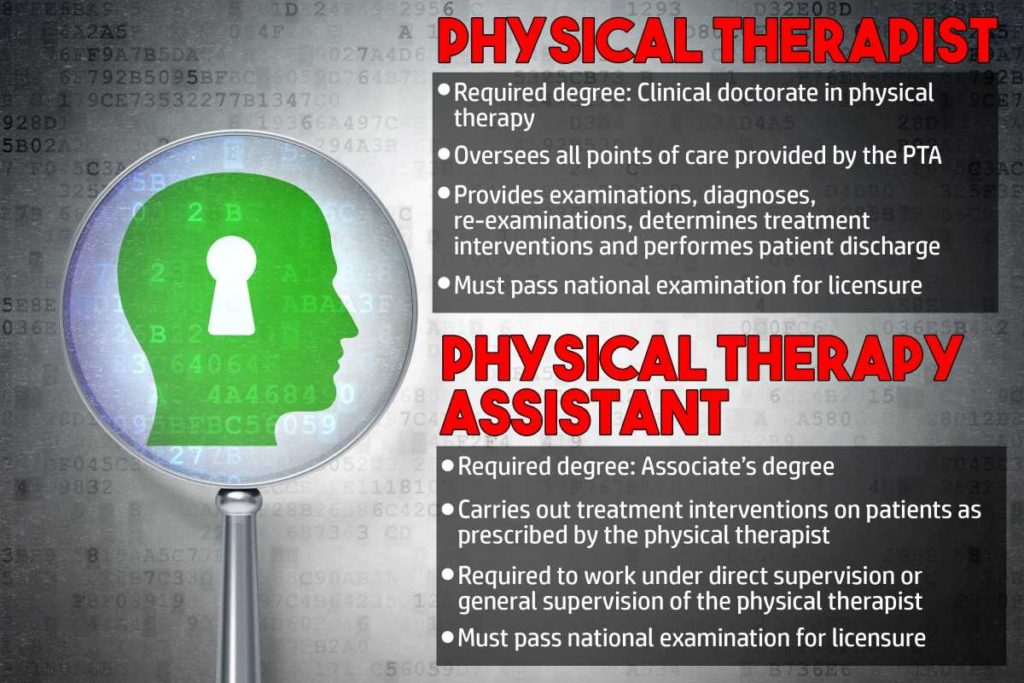Many people often times wonder what the differences are between a physical therapist (PT) and a physical therapist assistant (PTA). While they both work in a collaborative fashion and in ways that are designed to help patients through their rehabilitative process, there are important differences between the two.
Physical therapy assistants hold an associate’s degree and carry out treatment interventions on patients (such as therapeutic modalities, exercises, etc.) based on the examination findings and the treatment plan (which are conducted and prescribed by the physical therapist).
Physical therapists hold a master’s degree or clinical doctorate in the study of physical therapy and thus have more education and training along with a greater scope of practice than the PTA. Therefore, the PT oversees all points of care provided by the PTA.
It’s important to know that physical therapy assistants play a critical role in providing safe, high-quality and effective rehabilitation to patients who are receiving physical therapy. While the physical therapy assistant has a more limited scope of practice (discussed further within the article) than do physical therapists, they are integral to the rehabilitative field in numerous ways. Not all physical therapy clinics utilize PTAs within their practice, but many in fact do.
Similarities and differences in clinical roles of the PT and the PTA
There can be many similarities as well as differences when it comes to the differences in roles played between the PT and the PTA. While clinical operations can vary slightly from one clinic to the next, the similarities and differences discussed below are largely universal, unless there are unique local state-level differences.
If you want to read up on the specific document policies outlined by the APTA (American Physical Therapy Association), click this link here, where you can get a PDF document with all the fine details. Information following hereafter within this post is referenced from the APTA.
Similarities between the PT & PTA
Both the PT and the PTA serve roles of improving the patient’s quality of life through providing physical rehabilitation that aims to decrease pain, enhance movement, increase strength and endurance, etc. This is accomplished by helping the patient with physical tasks such as exercises, using therapeutic devices and providing education around the nature of their rehabilitation.
Whether the individual is a PT or a PTA, before entering clinical practice they must write and pass a national board examination (known as the NPTE), which is administered by the Federation of State Boards of Physical Therapy. The exam is specific to each program (that is, there is an exam specifically for the PT and an exam specifically for the PTA).
The PT and the PTA are only able to write their respective exam if the school they have attended is accredited through the Commission on Accreditation Physical Therapy Education (CAPTE-accredited). Once the respective individual has passed the exam, they are then able to obtain state licensure and begin working under their official designation.
Differences between the PT & PTA
The biggest difference that exists within clinical roles between the PT and the PTA is found within the differences in tasks carried out due to available scopes of practice by each professional (see the following section for more information). As a result, PTAs have a limited scope of practice and only provide treatment interventions to patients that have been prescribed or ordered by the PT.
PTAs do not evaluate the nature of the injury, disease or condition of the patient and cannot carry out treatment interventions that have not been ordered by the physical therapist (though they can appropriately adjust parameters of those specific interventions as a patient progresses or regresses through their rehabilitation).
It is important to note that the PTA is the only individual (aside from the physical therapist) who is legally able to provide treatment interventions to the patient receiving care. Physical therapy aids (such as a volunteer) cannot provide any therapeutic interventions.
Differences in scope of practice
Due to the difference in educational training (see the following section for more information), the PTA is always under the supervision and direction of the PT. The extent to which this supervision and direction can in fact vary based on a multitude of factors, however at the end of the day, the PTA is considered to be under supervision and direction of the PT.
Services that cannot be provided by the PTA (must be provided by the PT)
- Any such situation involving the interpretation of a patient’s medical condition, disease or injury. This includes patients who have already been evaluated or have yet to be evaluated.
- The very first examination of the patient (known as the initial examination) along with the subsequent evaluation for the patient’s condition, disease or injury.
- Any diagnosis (stating what is the cause of the patient’s condition or injury) and any prognosis (the outcome that can be expected with appropriate therapy and intervention).
- Re-examination of the patient, changing the goals of the patient’s treatment plan or any revision in the patient’s plan of care.
- Determining the discharge plan for the patient from their rehabilitation within the clinic.
Determining the PTA’s level of involvement and treatment
The extent to which a PTA will be involved with a patient’s rehabilitation will depend greatly on unique factors pertaining to the condition of the patient as well as the experience and abilities of the PTA. It is always the responsibility of the PT to determine the appropriate extent/level and type of involvement of the PTA when assigning therapeutic tasks for working with the patient.
Supervision requirements of the PTA
PTA’s are required to work under one of two types of supervision when treating patients within the clinic. Supervision can be classified as either general supervision or direct supervision. The type of supervision will depend on a variety of circumstances unique to the needs of the patient and the experience and abilities of the PTA themselves.
General supervision refers to the ability of the PTA to be legally permitted to treat a patient without the physical therapist in the facility. General supervision thus permits the physical therapist to be “off-site” while the PTA provides the designated treatment, but the physical therapist MUST be available by some form of telecommunications at the least.
Direct supervision refers to the PTA only being permitted to treat the patient when the supervising/overseeing physical therapist is present within the clinic at the same time. When direct supervision is required, the PTA thus must cease treatment if the physical therapist must leave the clinic (go off-site) and can only carry on with treatment once the physical therapist returns to the clinic.
Educational differences between the PT and the PTA
While both the PT and the PTA attend a specific program for their education, the level of education is different. It is this difference in level of education (and thus training) that provides such a difference in scope of practice between the PT and the PTA. To become a PTA, the individual must complete a two-year associate’s degree for a PTA program, which tend to be available at trade schools and community colleges.
The PT holds a master’s degree (typically two years in length) or clinical doctorate degree (typically three years in length) in physical therapy, which is preceded by completing a four-year undergraduate degree consisting of a specific number of prerequisite courses that are required to enter a PT program.
All PT schools within the US now require the three-year Doctor of Physical Therapy (DPT) degree. Individuals who are practicing as physical therapists with a master’s degree in physical therapy completed their schooling before the nationwide switch to the DPT degree that all current PT students must complete. It is the APTA’s (American Physical Therapy Association) to have all physical therapists with Master’s degrees upgrade to the Doctor of Physical Therapy degree, as part of their “vision 2020” campaign.
While both the PT and the PTA write a national board examination (known as the NPTE), these two exams cover topics and concepts specific to their level of training within school.
Concluding remarks
The PT and the PTA are a team found within many clinical physical therapy settings. While not all clinics utilize a PTA, many do. Though the scope of practice and clinical abilities are quite different between the PTA and the PT, they both serve to deliver effective and appropriate rehabilitation to patients in a safe and responsible manner.
The PTA always works under the supervision of the PT and only provides a specific aspect of the physical therapy process (treatment intervention that has been prescribed by the PT) due to the differences in education and training. The PT will always perform patient evaluations, interpretations in any findings as well as determine all aspects pertaining to the patient’s course of treatment, including their discharge.
Whether your rehabilitative treatment is carried out by a PT or a PTA, you’ll be in good hands. All PTs and PTAs must complete school-specific training, pass a national board examination and carry an active license before being legally able to work with and treat patients within a clinic.
Related Articles:
- Ten Reasons to Become a Physical Therapist for Your Career
- How Long (and What Does it Take) to Become a Physical Therapist?
- Job Satisfaction: Do Physical Therapists Enjoy Their Jobs?
- Is it Hard to Get Into PT School? Here Are the Facts!
- Debt: Is PT School Worth it? Here’s How You Decide

Hi! I’m Jim Wittstrom, PT, DPT, CSCS, Pn1.
I am a physical therapist who is passionate about all things pertaining to strength & conditioning, human movement, injury prevention and rehabilitation. I created StrengthResurgence.com in order to help others become stronger and healthier. I also love helping aspiring students and therapists fulfill their dreams of becoming successful in school and within their clinical PT practice. Thanks for checking out my site!



